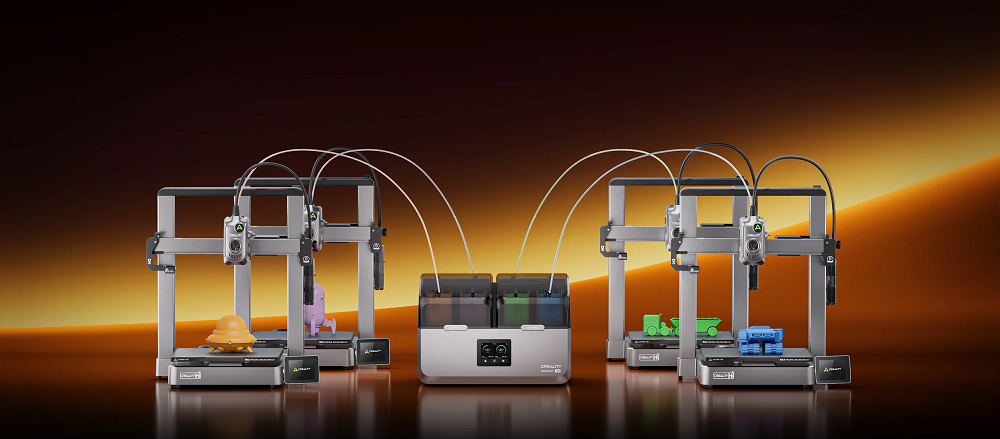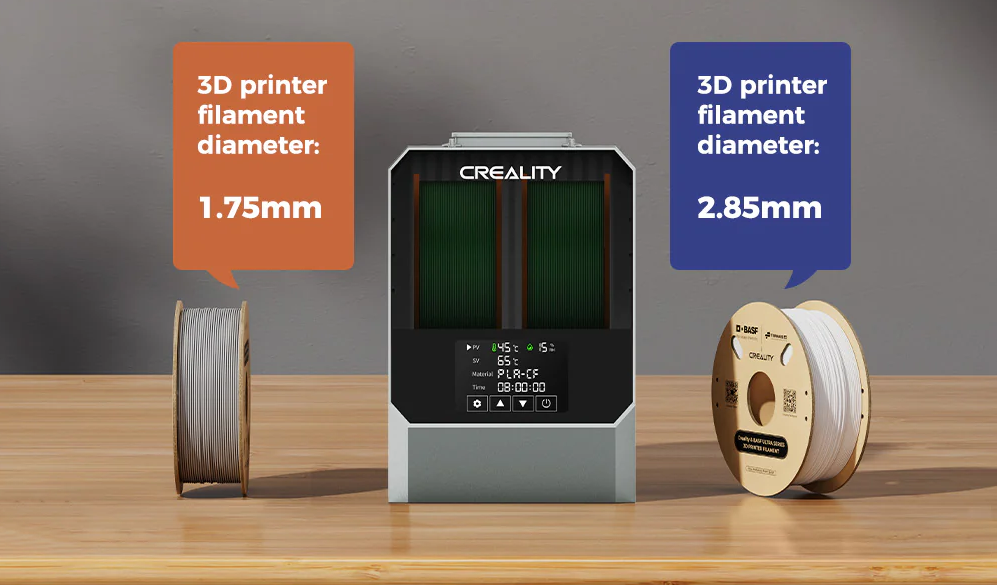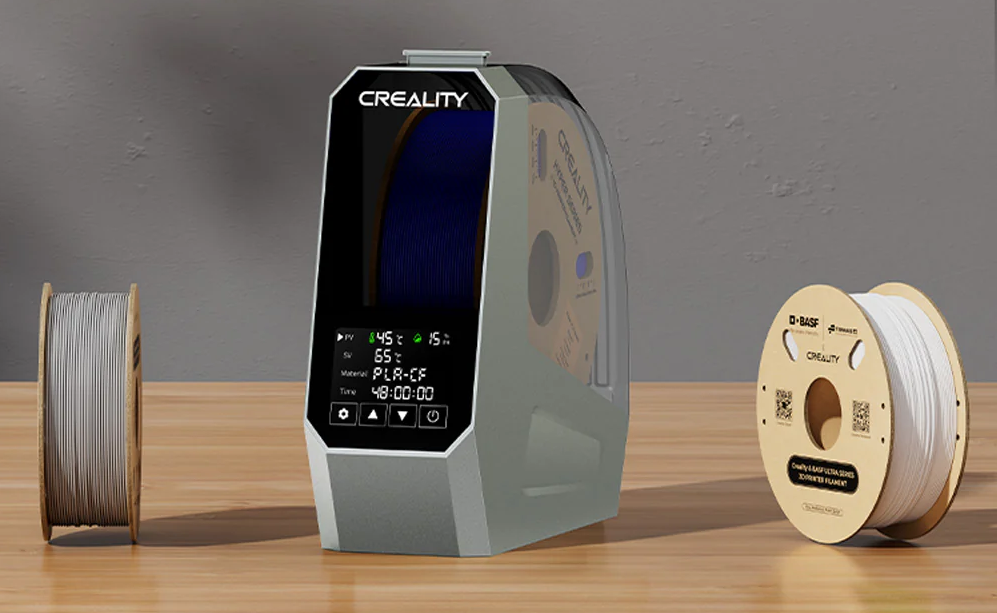Dealing with brittle PLA, clogged nozzles, or failed prints? Moisture could be to blame. Filaments like PLA, ABS, and PETG are hygroscopic, meaning they absorb humidity fast. Knowing how to store 3D printer filaments in the right way isn't just handy — it's the secret to having smooth, even prints.
In this post, we’ll explore the best filament dryer boxes in 2025, how to choose the right one, and several smart filament storage ideas, to keep your spools dry, protected, and print-ready at all times.
Why Proper Filament Storage Matters for 3D Printing
Though an important 3D printer accessory, a filament storage cabinet is often overlooked but key to successful 3D printing. Moisture affects print quality and material lifespan, so using proper storage or a filament dryer box will be time- and trouble-saving. Do you really need a spool dryer? Here's why:
✅ 1. It improves print quality Materials like PLA, ABS, and Nylon absorb air humidity, causing stringing, popping, bad layers, and surface imperfections. Proper storage cabinet keeps your material dry and in good printing quality.
✅ 2. It extends filament shelf life Filaments harden and become tough to print when exposed to humidity for a longer period. Store appropriately—sealed containers, silica gel, or active dryer—will keep your filament and give it an extended lifespan.
✅ 3. It reduces waste and failed prints
Abortive prints mean wasted time, energy, and materials. Dry filament averts you from incurring the typical moisture conditions of under-extrusion or nozzle clog, and it ensures your process with more efficiency and less waste.
✅ 4. It’s a must-have for sensitive filaments
Different types of filaments, particularly TPU, PETG, and Nylon are very sensitive to water. A filament drying box is a great necessity if you work with high-performance materials that demand precision and consistency.
✅ 5. It works better than passive storage
Pre-drying filament before each print eliminates troubleshooting protocols and permits other problems to be traced more quickly. It's a time saver, especially for commercial usage or heavy use.
How Does a Filament Dryer Work?
A dry box for filament uses heated air — and sometimes desiccants — to extract water from filament spools. Some models have temperature controls for specific materials, and others can hold multiple spools at once. Through rehydration and maintenance of filaments, they ensure better performance and print quality.
Filament dryer vs. filament dry box: What’s the difference?
While the terms are often used interchangeably, they can technically refer to somewhat different things. A filament dryer actually drives out moisture by heating it up, and it is best suited for rehabilitating soaked filament. A filament dry box tends to be more about maintaining filament dryness in storage or printing — although there are plenty of modern products that do both.
Best Filament Dry Boxes and Dryers in 2025 [Reviewed]
Now that you know what to look for in the main features, let's proceed with the top filament dry boxes and dryers of 2025. The top-rated cabinets provide performance, reliability, and ease of use to keep your filament in top dry shape and ready for each print.
How to Look for a Spool Dryer
When choosing the best filament dryer box, keep these key features in mind:
Capacity
-
How many spools the box will hold at once
-
How compatible the box is with your filament's diameter and spool size
-
Consider your printing volume: hobbyist vs. professional needs
Temperature control
-
Adjustable heat settings for different filament types (PLA, ABS, Nylon, etc.)
-
Precise temperature regulation to avoid filament damage or under-drying
Ease of use
-
Intuitive controls and easy-to-read digital screen displays
-
Low maintenance and easy setup required
-
Easy-to-use operation for hobbyists and professionals
Build quality & design
-
Durable, heat-resistant materials for long-term use
-
Assistive features like transparent tops for observing easy
-
Minimal footprint to clear space without diminishing functionality
Filament compatibility
-
Compatible with various filament materials and sizes
-
Versatile to fit standard and specialty filaments
-
Ensures your dryer works with your entire filament collection
Top 3 Best Filament Dry Boxes and Dryers
Looking for the best way to keep your filament dry and print-ready? Here are 3 top-rated filament dryers that stand out in 2025 for performance, design, and reliability.
Creality SpacePi X4
Creality’s original SpacePi filament dryer earned strong praise from the 3D printing community — for its excellent portability and great drying efficiency. Creality takes it a step further with the enhanced SpacePi X4, a 4-spool filament dryer designed for dedicated hobbyists. Just take a close look at how this filament storage device works:

Key features:
-
Two chambers with independent 200 W PTC heaters (max 85 °C)
-
Combined dehumidification with internal regeneration of the desiccant
-
3.2″ touchscreen display ("Easy Dry") with independent settings per chamber
-
Sealed fan design with smart airflow that protects against vacuum issues
-
Hold spools ≤200 mm diameter, ≤150 mm wide, filament 1.75 mm & 2.85 mm
-
360 W total power, quiet operation
Pros:
-
Large 4-spool capacity with independent temperature/humidity control
-
Highly accurate T/RH readings and smart dehumidification fans
-
Simple touchscreen operation; firmware updates easily available
-
Suitable for standard and engineering-grade materials alike
Cons:
-
High power draw (~360 W) could overload home circuits
-
No native direct feeding of printers—have to route the filament externally from the dryer
Best for: Hobbyists, prosumers, and small print farms who print constantly up to various materials and require consistent drying performance.
Verdict: The SpacePi X4 strikes an excellent balance of capacity, intelligence, and precise drying. Despite all its power usage and indirect feeding from the printer, its two-chamber setup and active dehumidification see it well worth recommending for heavy-duty 3D printing setups.
Creality Space Pi Plus
The Creality Space Pi Filament Dryer Plus is a dual-spool drying cabinet designed to store your filaments dry and print-ready. With temperature adjustability, real-time monitoring of humidity, and a simple-to-use touchscreen, it's ideal for makers who need steady, high-quality prints.

Key features:
-
Hold two 1 kg spools simultaneously, with two PTFE feed ports for feeding-on-print setups
-
Fast, even drying with dual PTC heaters and circulating fan
-
Choose from 12 preset filament types; manual range for quick and easy fine-tuning
-
Save your settings even in case of power loss
-
Display real-time humidity, temperature, and timer; easy control
Pros:
-
Dry up to two spools at the same time
-
Consistent drying performance
-
Easy presets for quick one-touch setup
-
PTFE outlets provide smooth closed-loop printing
-
Silent operation during cycles
Cons:
-
Tube can slide if not taped or hot-glued to the surface
-
Does not possess dry-box sealing
-
Certain users suffer from lag or touchscreen responsiveness irregularities
-
Does not possess spool rotation so drying is passive
Price: $89.99
Best for: Dual-printer owners or users who handle multiple filaments and need dry conditions for sensitive materials such as PETG, ABS, nylons, and carbon-fiber composites.
Verdict: The Space Pi Plus offers better drying for two spools with reliable performance, easy-to-use controls, and solid build—good price, as well. It produces real, concrete print-quality gains, especially for filaments that are sensitive to humidity. Other than that, it's not a dry-box and the PTFE port could use a locking mechanism.
Creality Space Pi
The Creality Space Pi is a robust, value-packed filament dryer—an excellent option for serious about upgrading your print quality to the next level. And, most importantly, this filament drybox boasts a rock-solid reputation on Reddit. If single-spool capacity and touchscreen quirks aren't deal-breakers, it's a smart addition to your setup.

Key features:
-
PTC 360° hot‑air heating (80 W) for even and consistent drying
-
Adjustable temperature (45–70 °C), with presets for 12 types of filament
-
48 h power-off memory timer
-
3.7‑inch touch-screen LCD display of real-time temp & humidity
-
1 spool, with 1 PTFE feed port for print while dry
-
Compact and quick to install, compatible with 1.75 mm and 2.85 mm filaments
Pros:
-
PTC heater + circulating fan produces uniform heat
-
Users report reduced stringing, clogging, better layer adhesion
-
Nice UI shows real-time humidity and temp; timer is flexible
-
Ideal for desktop use without taking up too much space
Cons:
-
Multiple reports of poor sensitivity and occasional glitches
-
Hold only one roll—limitations for users wanting to dry more at once
-
Lacks heavy insulation and thus not ideal as long-term dry storage
Best for: Enthusiasts printing with moisture-sensitive filaments and those who don’t require multi-spool drying or sealed storage.
Verdict: The Creality Space Pi Filament Dryer is a reliable, efficient, and well-designed tool for serious 3D print enthusiasts. It delivers consistent, moisture-free filament at a fair price. While the touchscreen is subpar and it only supports one spool, the core function—PTC heating, real-time monitoring, and improved print quality—is worth the expense.
Other Proved Filament Storage Solutions
Still not ready for a full-featured dryer? There are plenty of effective ways to store your filament safely. Look at these practical storage solutions that surpass regular dry boxes.
DIY Filament Dry Boxes
This is a simple, low-cost way of storing filament. Dampening and dust-repelling airtight containers provide top-quality filament protection. Add silica gel packets for added protection and humidity control.
Sealed Containers
These small bags remove air to reduce exposure to moisture. Most of them have battery-operated pumps and are best for those with little storage space. Best for extended storage of filaments.
Vacuum Storage Bags
For experience-seekers, a DIY dry box made of airtight containers, desiccants, and a heat source offers flexible, inexpensive protection. Great to try your own storage equipment at home.
Filament Storage Ideas for High-quality 3D Prints
Want to know more about how to store filaments? These are some effective and creative ideas to keep your filaments organized:
-
Organize by color and type of filament for faster selection of spools and to avoid cross-contamination when printing.
-
Label spools with print temperature and moisture status to track drying needs and printing requirements at a glance.
-
If it's possible, use intelligent sensors or IoT dry boxes to monitor humidity in real-time and send automated drying alerts.
-
Store filament in climate rooms to minimize temperature and humidity variations that lower filament quality.
-
Run routine filament drying based on usage cycle and ambient humidity levels to maintain filament performance over a period.
FAQs About the Best Filament Dry Boxes
Q: Can you dry 3D printer filament in an oven?
Yes, but do it with caution. Use an oven with precise temperature control and set it between 40°C–60°C (104°F–140°F) depending on the filament type. Never go over the suggested temperature to prevent the filament from melting or deforming.
Q: Can you dry 3D printer filament in a hair dryer?
Yes, technically, but it's not good. A hair dryer can blow dust or water back onto the filament and is not a flat, controlled heat source.
Q: How long does it take for PLA to dry out?
Drying PLA usually takes 4–6 hours at 45°C–50°C (113°F–122°F) with a decent filament dryer. Oven drying will take longer and needs close monitoring.
Q: How long do you leave filaments in the dryer?
It will depend on the material and how wet it has gotten. The majority of filaments only require 4–8 hours, but Nylon may require as much as 12 hours to dry.
Q: What is the cheapest way to keep filaments dry?
Use sealed containers with silica gel packs. This cheap method is effective at reducing humidity and increasing the shelf life of filaments without employing powered dryers.
Q: What temperature is a filament dryer box?
To accommodate materials like PLA, ABS, PETG, and nylon, the majority of filament drying boxes have temperature ranges of 40°C to 70°C (104°F to 158°F).
Summary
Moisture ruins filament—and your prints. From using sealed containers to investing in top-rated filament dryers like the Creality SpacePi X4 or Space Pi Plus, proper storage is the key to smooth, strong 3D prints.
Whether you’re a hobbyist or a pro, keeping filament dry isn’t optional—it’s essential. Ready to upgrade your setup and say goodbye to failed prints?
